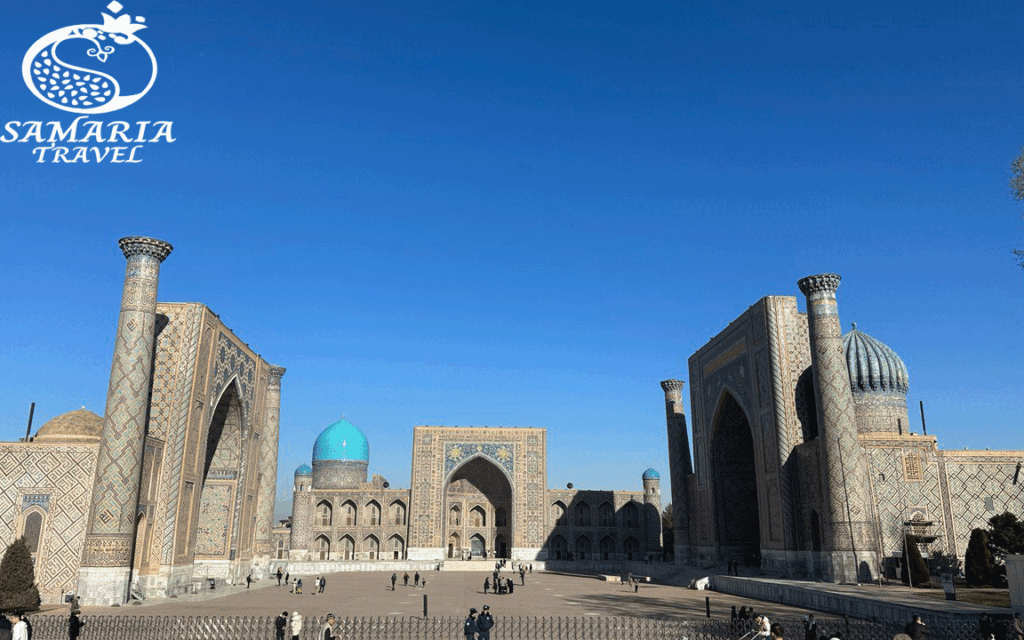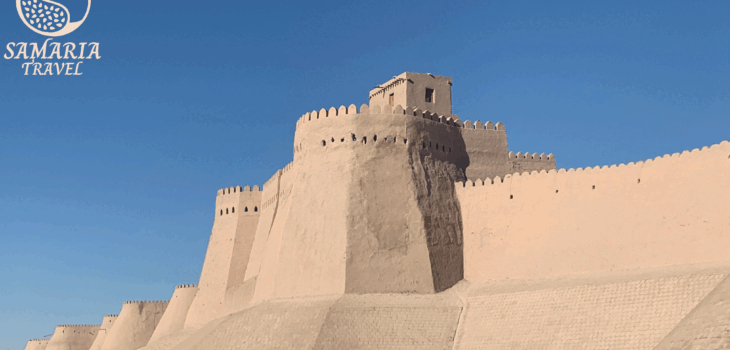
Uzbekistan 5 nights and 6 days top destinations: Tashkent—Khiva—Bukhara—Samarkand
TRIP OVERVIEW
Uzbekistan top destinations: Tashkent—Khiva—Bukhara—Samarkand. Travelers who are seeking to know more about ancient cities along the Great Silk Road and avoiding the hassle of organization will enjoy this six-day tour of a fairy tale city Samarkand, city of trade Bukhara, open air museum Khiva and the capital city of Uzbekistan Tashkent. In every city you will have an experience of local guide for sightseeing and you go at your own pace on this private tour. In all hotels you have connection to the Internet, breakfast, train and domestic flight tickets and entrance tickets for activities are all included.
Accommodation with breakfast is included
The itinerary can be customized based on your interests
Go at your own pace to explore the city with your local guide
Day 1: Arrival in Tashkent
Meet outside of airport terminal building by driver and transfer to hotel. Check in time to hotel is after 14:00.
Day 2: Fly Tashkent-Urgench, transfer from Urgench to Khiva and sightseeing in Khiva
The driver picks you up from your hotel in Tashkent at 5 am (flight is at 7 am).
Travelers should go outside of airport the terminal building and there is a metal fence and all people who come to meet passengers wait there. Our driver will be there with a name board and transfer to Khiva city which is 35 km.
The sightseeing in Ichan Qala Fort:
Muhammad Amin Khan Madrassa— (1855) the largest in the city and named after one of the city’s more impressive khans. Madrassa’s 125 hujra (rooms) cells, once housing the madrssa’s students, are currently home to the atmospheric Hotel Khiva.
Kalta Minor— belong to Muhammad Amin Khan Madrassa and supposed to be the world’s tallest minaret, but abandoned as too costly after the khan was murdered three years later.
Zindon— city jail.
Kunya Ark (“Kuhna Ark” in Uzbek)— fortified palace was built in XVII century by Arang Khan, son of Anusha khan. It was town within town, with its own defensive walls, mosques and offices, stables, arsenal and mint as well as residential areas. There is a watch tower and from the top is the best view of whole inner fortress—Ichan Kala.
Muhammad Rakhim Khan Madrassa— (1871) a museum dedicated to the khan, who was also known for his poetry, written under the name Feruz Shah.
Pakhlavan Mahmud Mausoleum— one of the holiest sites in Khiva which commemorates the poet, wrestler and patron saint of Khiva who died here in 1325. The XIX century tomb contains some of the city’s best tile work and also the largest cupola in Khiva.
Islam Khoja Madrassa— is named after the enlightened early XX century grand vizier who built public school and modern hospital. Built in 1908, it is the last Islamic monument to be built in the city before the arrival of the soviets.
Islam Khoja Minaret— the tallest minaret in the city (Note: climbing the minaret 100.000 sum per person and it is not included to the tour price).
Juma Mosque— (1788) supported by a dense forest of 213 wooden pillars that are cleverly arranged to allow the entire congregation a view of the mihrab (niche pointing the derection to Mecca). Aptly, the mosque holds an exhibition of carved karagach (elm) wood.
Tash Hauli Palace (“Stone Palace” in Uzbek)— (1832-38) home to the court of Allah Kuli Khan (1826-42) and a highlight of the city. A secret corridor connects the fabulously decorated inner harem (Note: separate entrance) to the reception court (ishrat hauli) and law courts. The intricately carved columns are particularly fine, as are the majolica tiles in the harem’s inner courtyard.
Day 3: Travel by train or transfer from Khiva to Bukhara with a private driver (you choose). Free time in Bukhara
Day 4: The sightseeing in old town Bukhara and afternoon catch a train to Samarkand
On this walking tour you learn about Art, history, old town, architectural monuments and food: The UNESCO listed city Bukhara has it all. Bukhara, one of the most ancient cities of Central Asia, has a 2500-year-old history. Bumichkat “New Castle”, Al Madina as-sufriyya “Copper City”, Madinat at-tujjor “City of Traders”, Foxira “Honorable City” are some the names given to this unique city.
The sightseeing in Bukhara city:
Ismail Samaniy mausoleum (IX-X centuries)— the oldest, best preserved and most breathtakingly original building in Bukhara.
The mausoleum of Chashmai Ayub (“Prophet Job”)— according to the legends the prophet Job came to the Zerafshan Valley and witnessed a great and terrible drought. As people perished of thirst around him, Job struck the dusty earth with his staff and a cool source of sweet spring water brought liquid salvation. The Chashmai Ayub (“the Spring of Job” in Uzbek) commemorates this site.
Bolo Hauz mosque (XVIII century)— it is a functioning Friday mosque from XVIII century and consists of reservoir, mosque and minaret (Note: this mosque you can visit from outside, since it is functioning Friday mosque).
The Citadel Ark (I-XX centuries)— the construction of the citadel is dated to beginning of the 1st millennium BC. During the history the fortress has been destroyed several times but has been restored again. All buildings of the citadel have been reconstructed mainly during the XVIII-XX centuries.
Poi Kalon complex (“The foot of tall” in Uzbek) from XII-XVI centuries. Consisting of mosque, madrassah and minaret, one of the great centre of trade and scholarship along the Silk Road. The beauty of the minaret amazed Genghis Khan (Temuchin or Temujin).
Magoki-Attari Mosque— Central Asia’s oldest surviving mosque. Prior to the Arab invasion there was a Buddhist monastery and then a Zoroastrian temple on the site. It now houses the dull Museum of the History of Carpet Weaving.
Labi Hauz Complex (“The edge of the pond” from Persian) constructed by Nadir Divan Begi, The Grand Vizier of Bukhara, around 1620.
XVI century Synagogue— to the south of Labi Hauz Square spreads the Jewish Quarter of the old town. Jews have been an important minority in Bukhara since their forced migration from Merv and Shiraz in the 14th century (the majority having emigrated to Israel and the US since 1970s). (Note: most of the time it is closed if it is open travelers can visit inside and see old Torah)
Statue of Hodja Nasruddin— the homespun philosopher and humorist on his donkey. Elsewhere in the world he is generally accepted as Turkish, but Uzbeks claim he was born in Bukhara and is one of their own.
Late afternoon transfer to Bukhara train Station 15 km and catch the train to Samarkand (subject to availability) upon arrival outside of train station of Samarkand met by driver and transfer to hotel.
Day 5: The sightseeing in Samarkand
Visit some of the top attractions in Samarkand on this day trip. Samarkand, one of the most ancient cities of the world, a contemporary of the Rome, Athens and Babylon, has a 2750-year-old history. “The Mirror of the World”, “The Garden of the Soul”, “The Jewel of Islam”, “The Precious Pearl of the Moslem World” are some the names given to this unique city. In ancient Greece, this city was known as Marakanda.
The sightseeing in Samarkand city:
The Ulugbek Observatory (Ulugh Beg Observatory), builtby Amir Temur’sgrandson astronomer-king Ulugbek in XV century.
The complex Shahi Zinda (“alive king” in Uzbek) from XII-XX centuries. Burial place of royal persons and nobles. One of the most spiritual place in Uzbekistan.
Bibi Hanim mosque XV century. The mosque was built in honour of Temur’s chief wife, Saray Mulk Khanum.
Local Siab market (“black river” in Uzbek)— (optional on the interests of your private group, note: Closed on Monday)
Gur-Amir mausoleum (“the tomb of the king” in Uzbek) from XV century.
Registan square (“sandy place” in Uzbek) from XV-XVII centuries. A spectacular architectural ensembles, with fantastic Islamic designs and calligraphy etched into the facades of its mosques and madrassahs.
Day 6: Transfer from Hotel in Samarkand to International Airport of the city for outbound flight
Product code: 449623P3




